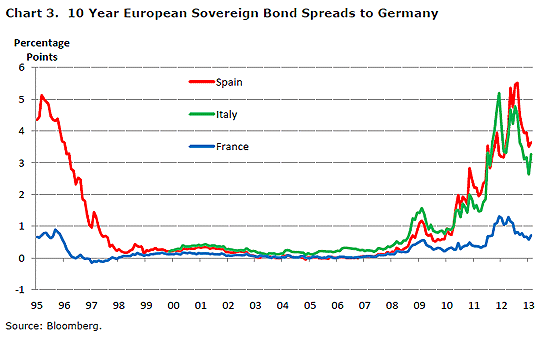
By Christian Hawkesby*

The RBNZ remains on the sidelines.
As expected, the RBNZ’s Official Cash Rate (OCR) was left unchanged in March at 2.50%. However, what surprised many in the market was the “dovish” tone to their Monetary Policy Statement (MPS).
Instead of another warning about the housing market, the RBNZ acknowledged that there are both upside and the downside risks to the NZ economy.1
For much of the past year, the RBNZ has been facing some very large offsetting forces on future inflation in New Zealand (Table 1).
The Canterbury rebuild and Auckland housing shortage will be strong tail winds; but the economy also faces strong headwinds from an extremely elevated currency and a big contraction in fiscal spending.
As well as an explicit reference to the downside risks to the economy, the statement contained an alternative interest rate scenario where the OCR was cut to 2.0% if the currency remains elevated.
There was little mention of the use of macro-prudential tools to cool the housing market.
However, that was a deliberate decision, given the RBNZ are in the middle of their formal consultation.
| Positive | Negative | |
| Near-term |
Business confidence Consumer confidence |
Inflation below target Drought |
| Medium-term |
Canterbury rebuild Auckland housing shortage |
Impact of elevated NZD Fiscal contraction |
It has also become clear from a number of the Cabinet ministers that the government is focused on tackling housing supply in Auckland, and that may alleviate the pressure on the RBNZ to use its policy tools.
In total, the MPS supported our view that the RBNZ are likely to be hold at 2.5% for 2013.
We see a greater risk of volatility in fixed interest markets to be driven by movements in global long-term bond yields, as this will ripple through the domestic market.
The RBA also now in wait-and-see mode
Since the middle of 2011, the Reserve Bank of Australia has been in easing mode, cutting their official cash rate to 3.00%, initially as a response to risks from Europe and then to provide some breathing space ahead of the forecast slowdown in capital expenditure (CAPEX) in the mining sector. Throughout this period, the market tended to predict another 25-100 basis points of cuts in RBA meetings ahead.
Evidence that the RBA’s rate cuts have provided some support to the Australian domestic sector has slowly been accumulating.
The most striking illustration of this was the most recent jobs numbers that suggested that a record 71,000 jobs were generated in February, including a very strong 17,000 full time jobs. With Australian unemployment remaining comfortably low at 5.4%, economists now expect the RBA to join the RBNZ in wait and see mode, with the market only pricing a small chance of further cuts.

US economic momentum continues
Over January and February, the US 10 year bond yield rose from 1.70% to as high as 2.10% as the market’s worst fears about the US fiscal cliff did not eventuate, and the US economy showed continued signs of economic recovery. We continue to be encouraged by the US economic outlook, as illustrated by positive economic surprises, strong business confidence, solid payrolls numbers, and the continual strengthening of the US housing market.

Cracks in Europe resurface
While the economic momentum in the US has been sustained through March, the US 10 year bond yield retreated back to around 1.85%, mostly driven by developments in Europe.
Economic data in Europe experienced another downturn, with most indicators pointing back towards very sluggish growth prospects for the region. At the same time, the European authorities undertook a very messy rescue of Cyprus, which served as a reminder of the social and political challenges that remain, and undid some of their hard work in 2012 to build market confidence in the European policy framework.
Investors had been aware for some time that Cyprus was likely to be the next European country requiring a bailout. However, the conditions of the rescue package, with depositors sharing the financial burden of the bailout, came as a surprise to markets. EU policymakers have been at pains to explain that Cyprus is a special case, with its large proportion of non-resident depositors (including Russian money of dubious origins) necessitating a different approach this time around.
The politics of Germans not wanting to bailout non-resident Russian money in Cyprus is understandable.

However, the bailout has left investors with frayed nerves, particularly with Italy still struggling to form a stable coalition government.
10 year Italian government bond yields have widened versus Germany. Sovereign Credit Default Swap (CDS) markets also suggest that some investors are betting that Slovenia will be the next small European country to face troubles. At the least, we should expect some bumps along the way in coming months.
Developments in Europe are one of the factors pointing us towards a more cautious approach to credit.
Like other parts of the fixed interest market, there are strong conflicting forces at play in NZ credit. On the one hand, the economic backdrop remains broadly supportive of credit, there is a lack of new supply, and strong Kiwisaver inflows to invest.
On the other hand, the pricing of credit is less attractive than the beginning of 2012 and risks of credit and funding market dislocation in Europe has increased.
We believe that there are merits to more cautious approach to credit, especially lower rated and subordinated securities.
Strong demand for NZ Government bonds
With Europe looking more fragile, New Zealand government bonds have benefited from flight to safety over March, with the NZ 10 year yield falling under 3.50% for the first time since January.
In addition to worries about Europe, strong demand for NZ government bonds has been driven by the upcoming maturity of the 15 April 2013 bond. This maturity will lengthen the duration of the NZ Government Stock Index by 0.8 years, encouraging some fund managers (that manage close to their benchmark) to demand more long-term bonds.
At the same time, the regular supply of nominal government bonds at weekly tenders has been cut back as the government’s finances have improved and they accommodate further issuance of the new inflation-linked bond maturing in 2025.

This mismatch between supply and demand has seen NZ government bonds become more expensive. This is perhaps best evidenced by NZ 10 year government yields falling almost in line with equivalent Australian government securities.
By contrast, in the past NZ 10 year government bonds yields have average around 0.30% higher than Australia, reflecting the better credit quality and liquidity of the Australian government bond market.
The NZ Debt Management Office (NZDMO) have announced that in April they intend to issue up to $2bn of a new nominal bond maturing in 2020. This could be one factor that helps pricing in the NZ government bonds normalise over coming months.
Market outlook
We continue to expect the RBNZ to remain on hold at 2.50% for 2013, balancing the conflicting forces of the Canterbury rebuild and the Auckland housing market against the elevated NZD, drought and fiscal contraction.
An increased focus by the government to tackle housing supply in Auckland may also alleviate the pressure on the RBNZ to use its policy tools.
We see a greater risk of volatility in fixed interest markets to be driven by movements in long-term bond yields.
Over the medium term, we continue to expect a gradual rise in global yields as the US economy continues to recover from its post GFC deleveraging.
Over the short-term, however, there are plenty of reasons in Europe for continued safe haven buying of US Treasuries, keeping yields relatively low for now.
In New Zealand, the maturity of the 15 April 2013 complicates the picture, and may generate some continued demand from fund managers as the duration of the NZ Government Stock Index lengthens.
However, over the medium term we see the relative value of NZ government bonds correcting, and yields following global bond yields gradually higher.
------------------------------------------------------------
Christian Hawkesby is a director of Harbour Asset Management and head of their fixed interest division. You can contact him here »
We welcome your comments below. If you are not already registered, please register to comment
Remember we welcome robust, respectful and insightful debate. We don't welcome abusive or defamatory comments and will de-register those repeatedly making such comments. Our current comment policy is here.